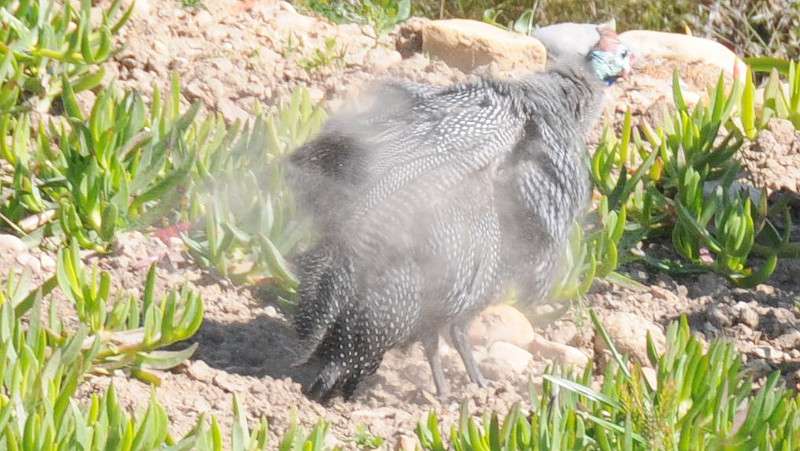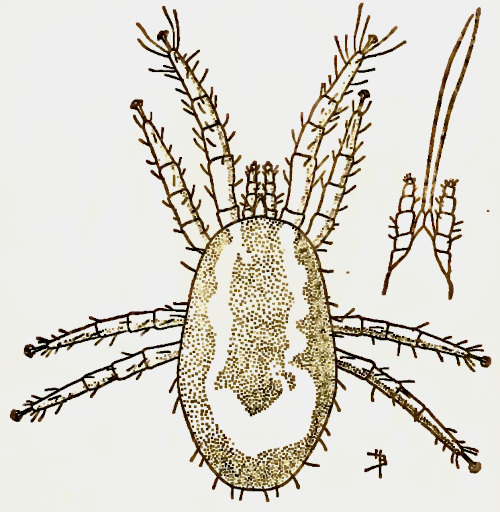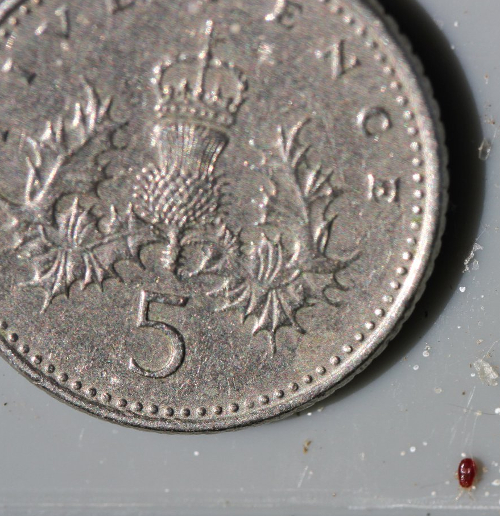Do Guinea fowl get parasites?

What parasites do Guineas commonly get?
Luckily Guinea fowl are comparatively hardy birds and seem to either avoid most parasites or have relative immunity to them but there are few that affect Guineas like Red mite, Northern fowl mite, lice and some internal parasites.
All animals carry parasites which have evolved to live on or in certain species, each species having their own type of parasite which may or may not live briefly on say, a human.
Some of the parasites are benign and some are pathological. Keeping all parasites at a low level should be the aim of poultry keepers.
Below: A fowl mite.

With all these external parasites, vigilance and observation in the hen-house with regular handling of your birds is the key to prevention and healthier, happier Guinea fowl. With internal parasites it is best to assume exposure and treat on a regular basis.
Warmer temperatures are ideal weather for the proliferation of mites and lice. If just the thought of crawly lice and biting mites makes you start to itch and shiver then imagine how the hens suffer from these pests, some of which can kill.
Prevention of parasites in Guinea fowl:
Guinea fowl need to be treated regularly with both a regular use preventative like Diatomaceous earth and Verm-X as well as a chemical wormer.
Any treatment suitable for chickens is good for Guineas and Flubenvet should be used on a regular basis.
External parasites of the Guinea fowl:
Red mite - Red Mite causes anaemia in birds and can pass disease on from bird to bird.
It is nocturnal and sucks the blood of the Guineas and other chickens at night, making it comparatively easy to control, but you have to be looking for it. A whitish powder is sometimes the only betraying factor around the perch sockets and around cracks in the woodwork and eggs may have tiny blood spots on the shell.
Red mites live in the hut during daylight and suck the blood of the birds at night causing anemia, debility and sometimes death. Red mite can live for 6 months without feeding and are then grey and very hungry.
Felt on the roof of the hen-house creates a sanctuary for red mite as they can crawl under there in the hated daylight and prove almost impossible to destroy, short of removing the felt. The actual size about 1 mm long and they are easily missed.
Below: A recently fed red mite.

Treatment that go on the bird are of limited use as the mite don't stay on the bird. The coop need to be treated with a suitable chemical treatment and then start a preventative regime with Diatomaceous earth.
Northern fowl mite - Is similar in size and colour to red mite but spends its entire life cycle on the bird quickly causing anaemia and death. Crested breeds are particularly prone to infestation and if controlling the mites with pyrethrum based powder make sure to sprinkle some down the ear canal as this is where they hide.
Infested birds have dirty looking patches on them and are depressed, cockerels tend to be more affected, but it is always worth checking the hens as well.
There are no licensed products to control Northern Fowl mite, but DM can of course be applied to a chicken if affected.
Northern Fowl Mite is passed from hen to hen, not as often carried by wild birds as red mite, and the most frequently exhibited birds are at the greatest risk.
Common chicken louse - This louse is flat, yellow, fast moving, about 2mm long, usually seen around the vent or under the wings but they move quickly out of the light as feathers are parted.
This also has its entire life cycle on the bird and is host specific and won't bite humans and feeds on the skin and feather debris.
The treatment is to dust with a pyrethrum based licensed louse powder or use Diatomaceous earth.
Scaly leg mite - Scaly leg mite causes intense irritation by burrowing under the scales of the leg, producing at first a whitish film and then mounds of white or pale yellow debris firmly attached to the leg.
In severe cases the crusts can cut off the circulation in the leg and gangrene can set in.
On a dark-legged bird, the beginnings of the white crusts can be easily seen.
Organic control is achieved by dunking the legs once a week for three weeks in a wide mouthed jar of surgical spirit, or putting a thick layer of petroleum jelly on the legs, which cuts off the air supply to the mites, but is rather messy.
Scales, like feathers, are moulted once a year, so after the crusts have fallen off (the flesh is raw beneath so do not pull the crusts off), heavily infested legs may take a year to look normal again.
Internal parasites of Guinea fowl:
Internal and digestive parasites need a regular chemical treatment.
Gapeworm - The gapeworm lives in the trachea of a bird and when eggs are laid, they are coughed up and excreted to infect the next chicken. The symptoms are snicking or gasping with throat extended.
Ascarids - Also known as roundworms, these live in the small intestine. If there are many of them they can impact, and this is fatal.
Tapeworm - These live in the intestine and cause weight loss and can be fatal.
Gizzard worm - These live in the gizzard and can be fatal in young stock.
Regular use of a recommended treatment should avoid the situation where a bird is so infected with internal parasites that death results.
Most intestinal worms have earthworms or insects as a transport host and wild birds are also carriers so outdoor birds are always at risk, although a certain amount of immunity develops.
Stress can alter the delicate balance and allow the intestinal worms to proliferate. Heavily grazed or stocked areas should be rotated to avoid a build up of internal parasites.
Even a low infestation of external or internal parasites causes economic loss, so it is sensible to treat for mites when found.
